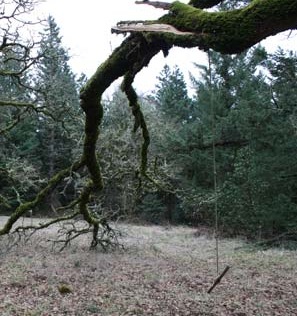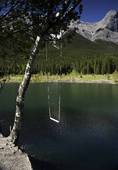Tree Swing Inspection
A tree swing (or a rope swing or tire swing) is composed of a single rope or chain attach ed to a high tree branch, along with a seat, which is typically a wooden plank or tire. For many homeowners, tree swings represent fond childhood memories, but this type of DIY play equipment is too often poorly constructed by non-professional builders for their children, who can be unaware of the potential dangers. InterNACHI inspectors who encounter these at property exteriors may wish to alert their clients of some of the hazards they pose.
ed to a high tree branch, along with a seat, which is typically a wooden plank or tire. For many homeowners, tree swings represent fond childhood memories, but this type of DIY play equipment is too often poorly constructed by non-professional builders for their children, who can be unaware of the potential dangers. InterNACHI inspectors who encounter these at property exteriors may wish to alert their clients of some of the hazards they pose.
Consider some recent tragedies. In 2010, a British girl enjoying her tree swing was killed when she was pinned to the ground by the falling silver birch, which is a tree species considered unsuitable for tree swings. That same year, an unsupervised boy accidentally hanged himself when he became tangled in the tree swing’s rope. Children are also killed or injured when ropes snap or hanger brackets dislodge. An article in the journal Pediatrics stated that “Recreational, single-rope tree swing injuries among children resulted in significant morbidity, regardless of the height of the fall. This activity carries a substantial risk for serious injury.”
To prevent accidents, inspectors and their clients can learn about what goes into a properly installed tree swing, and how to inspect them for potential hazards.
Tree Inspection
A sturdy tree is a must for a safe tree swing, but this consideration may be overlooked on properties that lack a variety of healthy trees from which to choose. Also, inspectors should remember that while trees appear stationary, they are actually alive and constantly, albeit slowly, growing and changing shape. As such, branches will “absorb” hanger brackets, and overhead branches will become brittle, gradually transforming what was once a properly installed tree swing into one that is no longer safe to use.
Check for the following indications that the tree will pose dangers to the user:
- inappropriate tree choice. According to London Play, an organization that promotes outdoor exercise for children, beech, oak, sycamore and Norway maple are suitable for rope swings, while pine, poplar, spruce, willow and silver birch should be avoided. Cherry, cedar and ash can be used only when their limbs are large and the tree is in good condition;

- the branch is too thin. The branch’s minimum thickness depends on the tree species, but, in general, it should be at least 8 inches thick;
- bulges, cracks and unusual swelling. These tree defects often lead to limb failure. If possible, the candidate limb should be inspected from above as well as from the ground;
- decay, fungus, or signs of hollowing within the tree. Dead wood is often dry and brittle and cannot bend in the wind under the stresses of the weight of a swinging child. Strike the tree at different points with a hammer to test for the sound of hollowing;
- poor tree architecture. While a tree that naturally leans may have no structural defects, straight trees that have started to lean recently may be damaged and in danger of collapse;
- cracks or seams where the branch forks from the larger limb. Weak unions indicate that the limb is at risk of tearing out; and
- dead or hanging branches above the swing. These should be secured or removed, as they are likely to dislodge from the motion of the moving swing.
Read InterNACHI’s article on Tree Dangers for more tips on how to spot dangerous situations posed by trees. Consult a qualified arborist if you have further concerns.
Ground Cover
Whether on purpose or by accident, sooner or later, children will fall from playground equipment, including rope swings, and the extent of their injuries will be determined, in part, by the condition of the ground beneath the swing.
Inspect for the following hazards that may make injuries more likely:
- asphalt, concrete or other types of hard surfaces. Grass or bare earth covered with leaves is usually safe, although additional safety can be provided by loose-fill material, such as mulch, wood chips, shredded rubber mulch, or engineered wood fiber. Earth that has been compacted by frequent foot traffic may be too hard;
- natural objects that may be tripped over or injure a child, such as rocks, exposed roots, stumps or branches from a neighboring tree. These objects should be removed so that only a flat surface remains;
- downward-sloped terrain. This will have the effect of accelerating the speed or adding to the distance for the child to dismount the swing, increasing the likelihood that s/he will trip and fall. Such a slope will also encourage the loss of leaves and other natural loose-fill material to wind and rain; and
- safe ground surface that extends only in a narrow path in front of and behind the swing. Tire swings, which permit a swinging motion in any axis, demand a larger safe-ground surface than other rope swings. The U.S. Consumer Product Safety Commission (CPSC) recommends installing a protective surface outward from the swing equal to the suspension rope plus 6 feet.
Water 
Tree swings are sometimes installed adjacent to ponds or rivers so the user has the option of a water landing. As exciting as this prospect may be, water presents its own set of dangers. A flotation device may be kept next to the tree so that it can be thrown into the water in case of an emergency.
Also, check for the following:
- water depth. Check to make sure that the water is sufficiently and uniformly deep within the fall range;
- sharp rocks, branches or other objects that can cause injury; and
- obvious exit. A steep-walled river can be difficult to escape, as can swift river currents.
Rope
A tree swing is only as strong as its rope or chain, so care should be taken to choose adequate material.
Check for the following rope defects:
- too thin. Rope that is too thin will either not support the weight of a swinging child or be difficult to adequately grasp;
- too thick. Ensure that the rope is not so thick that a child cannot easily grasp it. Rope that is an inch to 1-1/2 inches thick is typically sufficient, depending on the material;
- inadequate strength. Remember that as the user swings higher and higher, the tension in the rope or chain will equal several times the rider’s weight at the bottom of the arc. Therefore, the rope should be rated to withstand significantly greater weight than that of the intended rider;
- abrasiveness. Before wrapping the rope around the tree limb, protect the tree from abrasion and subsequent damage and weakening by wrapping a section of rubber around it; and
- unsafe, makeshift or additional ropes. Ensure that the rope does not create strangulation hazards. Also, check for any stray jump ropes, clotheslines, pet leashes, or anything else unnecessarily attached to the tree swing.
Seat
The seat should be high enough so that the user’s legs do not scrape the ground bu t not so high that the swing isn’t easily accessible or requires unsafe effort for the user to dismount. Remember that tree limbs can sway under the user’s weight, and weaker limbs might permit the seat to get too close to the ground. Sufficient clearance is roughly 10 inches between the ground and the user, which may translate into 16 inches for an unoccupied swing. A seat may be made from a wooden plank, which can be inspected for splinters, or a tire, which is usually suspended in a horizontal orientation using three suspension chains or cables connected to a single swivel mechanism that permits both rotation and a swinging motion in any axis.
t not so high that the swing isn’t easily accessible or requires unsafe effort for the user to dismount. Remember that tree limbs can sway under the user’s weight, and weaker limbs might permit the seat to get too close to the ground. Sufficient clearance is roughly 10 inches between the ground and the user, which may translate into 16 inches for an unoccupied swing. A seat may be made from a wooden plank, which can be inspected for splinters, or a tire, which is usually suspended in a horizontal orientation using three suspension chains or cables connected to a single swivel mechanism that permits both rotation and a swinging motion in any axis.
The tire may be a discarded vehicle tire or a plastic imitation, but it can present its own set of defects, including:
- exposed metal wires. Newer radial tires should not be used for a swing. In fact, the American Society of Testing and Materials (ASTM) explicitly advises against their use because they can become worn, exposing dangerous metal wires. Radial tires should be closely inspected for wear before their use. Older bias tires are usually safer to use for swings;

- using a heavy truck tire. This type of tire may be too heavy, causing the hanger clamp to dislodge. According to the ASTM, the entire rope swing assembly should not be greater than 35 pounds;
- no water drainage holes. Tires will collect rainwater if they lack holes through which water can drain; and
- beehives or hornets’ nests. Carefully inspect the interior of the tire for dangerous animals and insects and their nests, especially stinging insects, which may require special handling in order to remove safely.
Hanger Clamp
- poor clamp location. The hanger should be installed far enough away from the tree trunk that the user cannot inadvertently swing into the tree, especially if the swing permits horizontal motion. Likewise, the hanger should be placed at a point on the branch close enough to the tree trunk that the branch is of desirable strength and thickness;
- the clamp is not securely installed. If it detaches, the swing and its rider will fall to the ground. The CPSC has ordered a recall of tire swings manufactured by Miracle Recreation Equipment Company (model #714-852, #714-852-X and #278) for this safety defect due to reported injuries; and
- pinch points. Hanger clamps, especially for multi-axis tire swings, should not have any accessible pinch points.
Additional Inspection Tips
- Check for signs of vandalism. Even if intended as a harmless prank, disaster can result from a partially cut rope.
- Supervise children at play. Children may stand on the swing, swing excessively high to outdo a friend, or spin the swing to create dizziness. A little supervision can mean the difference between childhood antics and serious danger.
- Remove drawstrings from children’s clothing, as they can become attached to the moving swing and create a strangulation hazard.
- Remove the swing in bad weather if it may become damaged or damage the tree.
- Clean, sand and repaint rusted areas as needed.
- Occasionally inspect the condition of the equipment for signs of wear (especially after a season of harsh or inclement weather), such as splintering wooden surfaces, damaged suspension ropes, broken and missing components, and bent pipes or tubing.
- Ensure that protective caps and plugs which cover bolt and tubing ends are in place and secure.
- Periodically oil any moving metal parts.
- Maintain loose-fill surfacing beneath the swing.
Other valuable information can be found in IntertNACHI’s article on Playground Equipment Hazards and Inspection.

